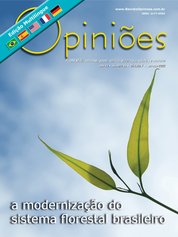Gustavo Torres Galvão da Silva
Especialista em Desenvolvimento Operacional da Gerdau
OpCP69
A tecnologia é a ponte para consolidar a modernização florestal
A modernização florestal é uma realidade no campo e vem se especializando no Brasil desde a chegada dos primeiros equipamentos da agricultura. Com isso, os avanços tecnológicos vêm trazendo ao meio rural maiores condições para o planejamento, segurança, desenvolvimento das operações, aumento da produtividade, maior conectividade e redução dos custos.
Antigamente, os equipamentos destinados à agricultura eram rudimentares. No decorrer dos últimos anos, alguns avanços tecnológicos foram marcos históricos, como o desenvolvimento do primeiro arado de lâmina produzido com madeira e o machado na colheita. No início do século XX, a mecanização e o conhecimento científico começaram a mudar o cenário no meio rural. Os animais que puxavam o arado e as carroças com madeiras deram lugar às máquinas movidas a motores de combustão.
Com o passar dos anos, os equipamentos mecanizados destinados à agricultura foram sendo utilizados nas grandes produções florestais, a fim de trazer otimizações às plantações. Todavia ainda não eram adequados o suficiente e também não havia grandes recursos logísticos para reposições de peças importadas. No entanto, com o avanço tecnológico, a mecanização chegou também aos pequenos e médios produtores, que se beneficiaram da tecnologia para aumentar suas produções.
Segundo levantamento realizado pelo IPEF, Instituto de Pesquisa e Estudos Florestais, em 2021, os tratores agrícolas representam 77% da frota em grandes empresas, os tratores florestais 20% e os tratores de esteira, pouco mais que 2%. Considera-se que, na maioria dos casos, os tratores agrícolas necessitam de adaptações para, principalmente, cumprirem as normas de segurança e apresentarem maior disponibilidade mecânica no campo.
Apesar de a mecanização em algumas atividades, como colheita e transporte de madeira, ter evoluído significativamente, outras, como a silvicultura, ainda encontram grandes desafios. Hoje, a indústria de equipamentos agrícolas identificou um nicho de mercado na silvicultura e de colheita, apresentando soluções e equipamentos para o setor florestal, como máquinas de colheita sendo operadas remotamente; plantadeiras com inteligência artificial; irrigação automatizada de forma localizada – que identifica as mudas em tempo real –; uso de drones para pulverizações, iscas formicidas, soltura de inimigos naturais, monitoramento, avaliações de qualidade, entre outros.
Embora os impactos positivos na produção florestal e na agricultura tenham sido notáveis, criou-se um contingente de pessoas que perderam sua força de trabalho no campo, buscando, assim, novas oportunidades nos maiores centros urbanos, o que impactou conjuntamente as produções florestais. As pessoas que migram não tendem a voltar ao trabalho de campo ofertado pela silvicultura, e isso se deve às condições de trabalho encontradas, como exposição ao sol e à chuva. As empresas já têm sentido esse impacto por meio do absenteísmo.
Com isso, as organizações estão investindo no desenvolvimento operacional, a fim de migrar as atividades manuais para operações mecanizadas ou, ainda mais, automatizadas. No levantamento realizado com 17 empresas florestais, o IPEF identificou que 48,5% das atividades de silvicultura são mecanizadas, 45% das atividades florestais são manuais, 6%, semimecanizadas e apenas 0,14%, automatizada.
Dessa forma, ainda se torna necessária a disponibilidade de mão de obra especializada no campo para operar máquinas florestais e realizar manutenções. Para suprir isso, as empresas florestais têm buscado capacitar cada vez mais os profissionais.
Olhando para o futuro, o rápido processo de desenvolvimento tecnológico, permeado pelo uso da inteligência artificial e acompanhado por avanços disruptivos das ciências na fronteira do conhecimento, transformará os sistemas florestais com maior eficiência. No novo contexto, passaremos a utilizar veículos autônomos, drones e robôs com sensores nas produções florestais. Isso dará entrada a um grande volume de dados e será impulsionado pela potência dos sistemas computacionais e pela conectividade, levando transformações significativas na forma de se manejarem os cultivos florestais.
Todavia a conectividade rural no Brasil é um grande desafio. De acordo com dados do Instituto Interamericano de Cooperação para a Agricultura (IICA), a maior dificuldade no campo é a obtenção de um sinal de internet de qualidade, havendo áreas onde ele não existe.
A conectividade pode trazer ganhos significativos para o desenvolvimento operacional, como o auxílio no sistema de piloto automático, interpretação das análises climáticas, o que, consequentemente, evitará perdas e possibilitará um trabalho de forma mais otimizada. Essa conexão entre os dispositivos juntamente com coleta e armazenamento em tempo real geram um grande volume de informações relevantes para a análise de dados apurada, capaz de prever cenários em relação à produção.
Além disso, o uso de sensores e telemetria vem sendo cada vez mais frequente. Eles fornecem uma série de informações sobre temperatura, umidade, ar, solo, além de obtenção de dados, através de GPS e monitores embarcados. Dessa forma, colaborando com a alimentação de um banco de dados mais robusto, podem auxiliar cada vez mais o avanço na produção florestal, através de comparativos retroativos e predição com base em informações ambientais.
Com o avanço das tecnologias, softwares para monitoramento remoto também têm sido aprimorados, a exemplo dos Sistemas de Informações Geográficas (SIG), que permitem o mapeamento de grandes áreas, a identificação de falhas operacionais, além de fornecerem informações correlacionadas para o planejamento florestal que permitem a melhoria nas operações.
Com a internet das coisas (IoT), a interconexão de dispositivos e máquinas florestais trazem ao mercado opções, como trator conectado à plantadeira, que estará conectada ao pulverizador, à adubadora e assim por diante. Todas as modernizações atreladas ao Big Data permitem a transformação de dados isolados para informações úteis à produção no campo. Isso provoca uma sinergia e otimiza os processos florestais cada vez mais.




